Whether you own a car or not, knowing the answer to car-related questions like what happens if you put too much oil in your car is a must. Automobiles have become an integral part of our lives. So, it is a necessity that you know at least essential things about them.
The engine is the heart and soul of a vehicle. To ensure your ride runs smoothly, you need to take extra care of the machine by using the accurate amount of engine oil. Engine oil is the food for your engine. Having it in less or excessive quantity is equally harmful.
If you are among the people who think only less oil can harm the engine, then think again. Having too much oil in the engine oil tank can damage your vehicle for good if not taken care of.
So, if you are surrounded with engine oil-related queries like how much is too much oil in the car or will oil light come on if too much oil in the machine, we are here to help. In this article, we will provide you with a step-by-step guide that will tell you what happens when you overfill your motor oil in your car and how to check and correct it.
What Are The Signs Of Engine Oil Overfill?
Before we learn about what happens if you put too much oil in your car, you must learn how to find out if there is an oil-related issue with your ride. Mistakes are bound to happen even when you are extremely careful. Even professionals make mistakes with vehicles, so do not beat yourself up if you do something like overfilling the oil tank.
As a car rider, you need to understand that a car’s oil tank is built to accommodate a certain quantity of oil. Please understand that oil volume will expand as the temperature of the engine rises.
So, if you already fill the oil tank reservoir to the brim, it is going to cause leaks and other issues, which can then severely damage your SUV, sleeper car, sports car, or a luxury ride if not taken care of. Below, we have a list of X too much oil in engine symptoms that every car owner or driver should know:
A. Thick White Smoke Fumes
If you have recently changed your motor oil and have encountered thick white smoke coming out of the engine, it is a sign that you have overfilled the oil tank.
Excess oil burns as soon as it gets in contact with heated engine parts. So, if you see those white fumes, stop, let the engine cool down, and then inspect.
B. Check Engine Light Is On
When you overfill your car with engine oil, the excessive oil can cause a rise in overall oil pressure in your engine. This rise in pressure then triggers the check engine light to come on.
So, if your check engine comes on after you have just refilled your motor oil tank, do not panic. Simply, check the oil level in the tank. If the oil level is right, then there might be some other issue with the engine.
C. Oil Leak
Whether you own a vehicle from a European car brand or a Japanese car brand, they all behave similarly when you put too much oil in your car. So, if after the oil change, you find an oil puddle underneath your four-wheeler, it could be a sign that your engine oil might have overflowed.
To be sure, we recommend you check under your car for leaks in the oil pan gasket. An oil leak can also occur if the gasket is loose.
D. Smell Of Burning Oil
The following symptom that will take us one step closer to what happens if you put too much oil in your car is the smell of burning oil.
If you smell burning oil in your engine compartment or at the rear of the exhaust system, you should immediately check your vehicle’s motor oil level.
E. Screeching or Grinding Noises From The Engine
If you hear screeching or grinding noises coming from the engine while driving, it is another sign that you might have an overflowing engine oil issue. The best way to ensure it is to stop and park your car on a level surface. Let the engine cool down, open the hood, and check the engine oil quantity with the help of a dipstick.
F. Engine Misfiring, Stalling, or Rough Idling
If you find your fun car engine misfiring, stalling, or rough idling after you recently changed the oil in your ride, there is a high chance you overflowed your motor oil tank.
G. Poor Or Weak Acceleration
Too much engine oil is one of the main reasons for poor acceleration. If you are driving your ride and all of a sudden it feels lethargic after that last oil and fluid draining & refilling, you may have filled the oil tank reservoir more than required. Either check for the issue yourself or have a professional mechanic take a look at your ride.
How To Fix Too Much Oil In Your Car?
Now that you know what happens if you put too much oil in your car, it is time to move forward. Simply knowing how to determine if engine oil is overfilling or its consequences is not enough.
As a car owner, you should know what to do after you find excessive engine oil issues in your ride. Overfilled engine oil issue is something that you should address as soon as possible.
Neglecting it will only cause potential engine damage and more strain on your pocket. Here we have some steps that will help you fix your overflowing engine oil problem:
1. Check The Engine Oil Level
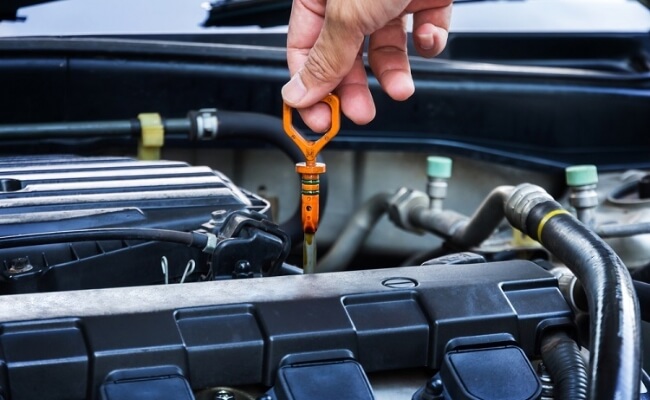
To make your cute car run smoothly like before, you first need to check its engine oil level. You can use the dipstick to do the task. Determining the oil level will let you know how much oil you need to remove.
2. Remove or Drain the Excess Oil
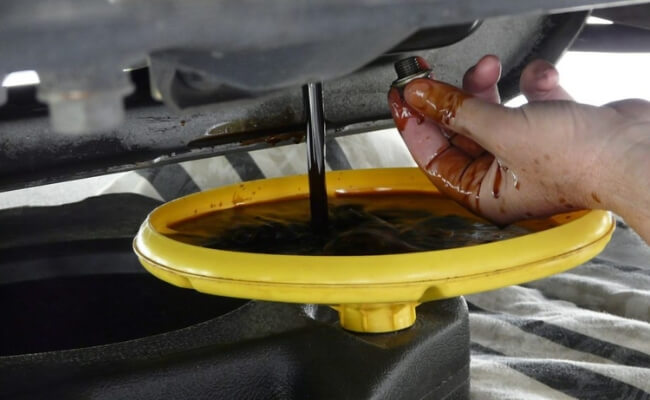
After determining the oil level you need to remove from the tank, it is time to get on it. You can get rid of that overflowing motor oil in two ways.
3. Use Oil Suction Pump
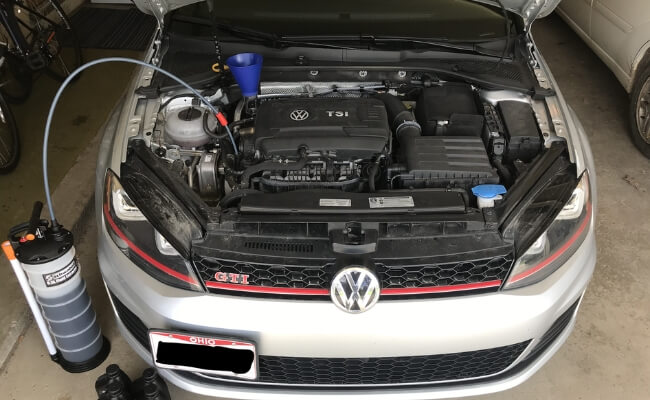
The first method is simple and effortless. You need an oil suction pump to draw out the oil via the access point in the dipstick tube. There is no need to lift your car. All you need is a vacuum pump to extract the oil.
Also Check:
You need to be attentive to the process as you do not want to remove oil more than required. For this, keep checking the oil level periodically with the dipstick. However, if you have no experience doing this or do not have any specialized tools like a vacuum or suction pump, we don’t recommend trying this method.
4. Use Oil Pan & Socket Wrench
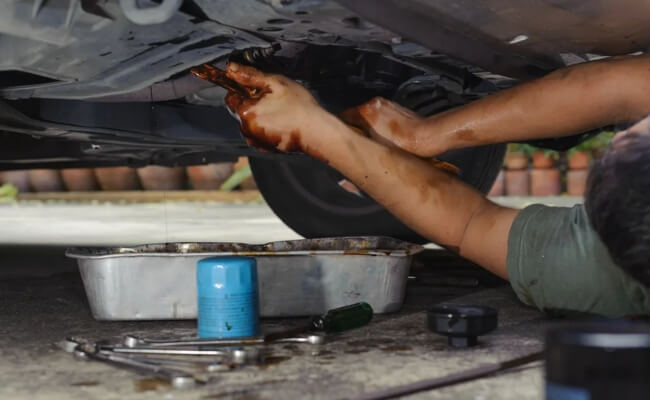
The second method is more laborious than the first one. You must raise your car high enough to easily crawl under it. Locate the oil plug. Now loosen the oil plug with your socket wrench’s help until the oil drips.
Place the oil pan under it. Do not remove excessive oil at once. Remove the oil only in small quantities. Once enough is removed, tighten the oil plug, and then go to the hood and check the oil level with the help of the dipstick. Keep repeating the process until the correct oil level is achieved.
5. Replace The Oil Filter
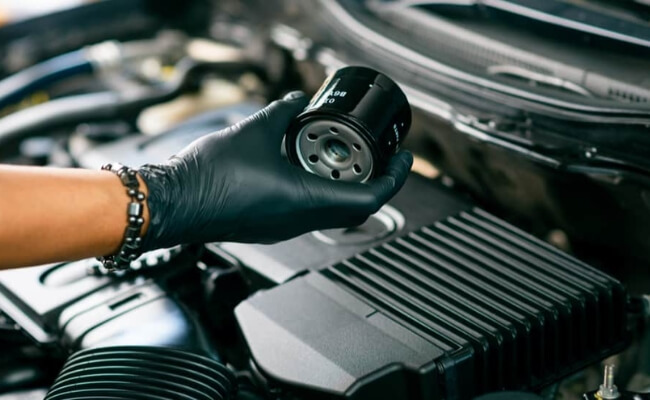
Now that you have achieved the required engine oil level, you must replace that oil filter. You might think, why remove the oil filter? Well, the answer is there are high chances of the oil filter getting damaged or failing due to oil overfilling. Thus, it is safe if you replace it before the occurrence of any problem.
6. Start The Engine

Once you are okay with the oil level and have accurately replaced the oil filter, it is time to do the final check. Start your engine and look for any symptoms associated with overfilling engine oil, like unusual engine noises, leaks, etc. If everything is okay, you are in the clear to drive your ride.
But there is one crucial thing. If you are not sure enough to perform these steps yourself, it is always best to seek professional assistance.
What Happens If You Put Too Much Oil In Your Car?
If you fill your engine oil tank with more quantity than required, your vehicle can be affected in many harmful ways. Whether you have overfilled engine oil by 1 liter, more or less, it will degrade your car engine with time.
The best thing you can do is keep a close eye on the overfilled engine oil symptoms to catch the issue before it worsens. However, suppose you miss them or cannot understand what your ride is trying to convey.
In that case, you need to know what would result from your negligence. Here, we have listed some significant problems resulting from an overfilled engine. If you do not fix them promptly, you will end up with a busted car that is no good in the brand new or used car market.
A. Oil Leaks
The unwanted level of engine oil leads to the transmission of excessive oil past the piston rings and into the combustion chamber. The presence of engine oil in the combustion chamber leads to oil burning, foul spark plugs, and increased harmful emissions.
Not only this, the oil may also leak from seals and gaskets, creating a mess in the chamber and potentially damaging other engine components.
Also Check:
B. Excessive Pressure On Crankshaft
A crankshaft is a crucial mechanical component of your engine. When there is adequate pressure on the crankshaft, it prevents leaking in the machine. However, the excessive oil in the engine causes extreme pressure in the crankshaft component, causing the leak.
This interference of excess oil with the crankshaft’s rotation can lead to increased friction and heat, ultimately leading to engine failure.
C. Increase In Oil Pressure
The overflowing engine oil can raise the oil pressure inside your car’s engine. This pressure increase may damage oil seals and gaskets, leading to leaks and ruining engine functionality.
D. Decrease In Engine Performance
Overflowing motor oil does not always create a big mess immediately. It is like a slow killer. The overfilled engine can increase the resistance in your pickup or compact car’s rotating components. And this unwanted resistance leads to a decrease in your engine’s overall performance and gas mileage.
E. Catalytic Converter Damage
Excessive oil burning in the combustion chamber also leads to the contamination of the catalytic converter. This contamination leads to a reduction in the effectiveness of the catalytic converter and causes potential engine damage.
F. Damage To Seals And Gaskets
Another result that you can add to the answer to your question, “What happens if you put too much oil in your car?” is damage to seals and gaskets in the engine. The overflowing engine oil can cause excessive pressure on the engine’s seals and gaskets. Such high pressure leads to leakage and permanent damage to the engine.
Also Check:
G. Engine Damage
Due to overflowing engine oil, the oil pressure will be off. This means the engine components will not be adequately lubricated. This will cause the engine to deteriorate quickly. You will no longer have smooth sailing on your ride. Also, shifting gears will be a big headache for you.
H. Foaming And Aeration
Excessive engine oil can cause the crankshaft to whip that oil into a froth, further leading to aeration and foaming. This occurrence reduces the motor oil’s ability to lubricate and cool the engine components effectively. And thus leading to severe engine damage.
I. Wet Spark Plug
The excess oil in the engine can also reach the spark plugs and wet them. Oiled spark plugs can increase your car’s fuel consumption and even affect your automobile’s acceleration. This is why it is so important that the spark plugs are always in good condition. An oil leak can ruin the spark plugs so severely that your only option is to replace them.
How Do You Determine If Your Engine Has Too Much Oil?
Checking the engine oil level of your car is an easy process. You do not need to be a car wizard or a professional. All you need to know is the correct procedure to follow. Below is a step-by-step guide for beginners to check engine oil levels without any fuss.
- The first thing you need to do is park your car on a level surface. Avoid any kind of inclination. For example, on the way to the garage or leaning against the body with two wheels on the sidewalk can significantly falsify the actual result.
- Open the hood of your car and locate the dipstick. It’s usually light with a round or T-shaped handle. It is generally located at the top front of the hood near the oil filter.
- After locating the dipstick, remove it carefully and clean it.
- After cleaning the excess oil from the dipstick, examine it carefully. There will be two markings on it labeled as LOW and HIGH. If your dipstick does not have HIGH and LOW written, look for two pinholes, letters L & H, or MIN and MAX abbreviations.
- Put the dipstick in the engine oil tank until it clicks into place. Remove the stick and check for the oil streak on it.
- If the oil streak is between LOW and HIGH markings, the oil level in your engine is acceptable.
- We recommend adding more oil if the oil streak is below the middle between the two markings or below the LOW marking.
- If the oil streak is above the HIGH marking, remove the extra oil to improve your vehicle.
- Apart from this, you also need to know how much oil your car needs.
Also Check:
For this, you need to understand your vehicle oil requirements. And for that, refer to your owner’s manual.
How Much Oil Does A Car Need?
The engine oil requirement varies from car to car based on the engines. The larger the engine capacity of your vehicle, the more motor oil it will require, and vice versa.
Generally, most American car engines require 3 to 8 liters of oil for smooth operation.
- 3-cylinder engines need 3 liters of oil
- 4-cylinder engines require around 4.5 liters of oil
- 6-cylinder engines use 5.5 liters of oil
- 8-cylinder engines need more oil, approximately 4.5 liters to 7.5 liters of oil
Thus, before changing or adding motor oil to your engine, know its actual oil requirement. For this, you can refer to your owner’s manual.
It will tell you exactly how much oil you need and what happens if you put too much oil in your car. Not only this, but the manual will also contain details on the type of oil that your car manufacturer recommends using.
Top FAQs About How To Fix Too Much Oil In Car
What do you do when you notice the engine is overfilled with oil?
When you detect engine oil overfill, the first thing to do is park your ride on a flat surface. Ensure there are no curves or inclinations.
Now, it is time to remove the excess oil. You can do this with the help of a suction pump or dipstick tube.
However, if you don’t have any of these, you can quickly drain out all oil by loosening the drain plug. But before you do this method, ensure you have something to collect the entire oil for its safe disposal.
To avoid such a situation, experts recommend checking your engine oil level regularly with the help of a dipstick.
How much oil is too much on the dipstick?
A dipstick comes with two markings labeled as HIGH and LOW. These two markings represent the engine oil tank’s maximum and minimum engine oil levels.
Clean your dipstick and insert it in the tank to know how much oil is in your motor oil reservoir.
Remove it gently and examine the oil streak formed on it. Your oil level is good if the oil streak is between the LOW and HIGH markings.
However, if the streak touches the HIGH mark, your ride has excessive engine oil, and you need to remove the extra oil immediately.
And if the streak is touching only the LOW marking, your ride lacks engine oil, and you need to put more in it.
How do you remove excess oil from your engine?
There are several ways to remove excessive motor oil from your engine. First, you can take your car to a professional mechanic and have them do the task for you.
However, if you are willing to perform the task yourself, you can either drip the excessive oil from the tank or go for a fresh oil change.
You can remove the oil drain plug from the bottom of the oil pan. Drip out the oil in small quantities if you only want to eliminate the excessive oil.
To check if the oil has reached the desired level, seal the oil drain plug and, with the help of a dipstick, check the oil level. Repeat the process until the desired oil level is achieved.
If following the above method is too hectic for you, you can drain the entire oil from the oil pan, seal the drain plug, and pour the fresh oil.
How long can I run my car with too much oil?
Driving your car with too much engine oil is not recommended. Doing so will only put more strain on the engine, causing severe damage to the machinery.
So, as soon as you find out about the issue, change the oil as quickly as possible.
If you have a professional do it for you, have a tow service company take your car to the mechanic.
This way, you will save your car engine from any damage from driving there with overflowing motor oil.
How do you check your oil level by reading a dipstick?
While driving, if you notice any of the above-mentioned excess oil symptoms, you simply need to stop your car on flat ground.
Turn off the engine, open the hood of your car, and locate the dipstick. After finding it, wipe it off and place it inside the engine oil tank.
Now, pull out the dipstick after a few seconds and check the formation of an oil streak. You are good to go if the oil streak is between the High and Low-level indicators.
If the oil streak is touching either High or Low indicator markings, you must either drain excess oil or pour some more.
How can I prevent oil overfilling in the future?
If you want to ensure the smooth running of your engine for a long time, ensure all the required oils and fluids are in the recommended quantity.
To know the correct quantity of engine oil required for your ride, refer to your car’s owner’s manual.
The manual has all the crucial information about your ride. Do not exceed or subside the oil level recommended by your car manufacturer. Also, have a professional look at your car at least once every month to ensure everything is okay.
Conclusion
What happens if you put too much oil in your car is something every car owner should worry about. Overfilling your car with oil is a big problem that can damage your engine permanently if not taken care of.
Thus, you need to keep the engine oil level as your car manufacturer recommends and check the oil level at least once every two weeks. Pay more attention to your engine’s oils & fluids to keep it in better shape.
Discover more from Locar Deals
Subscribe to get the latest posts to your email.

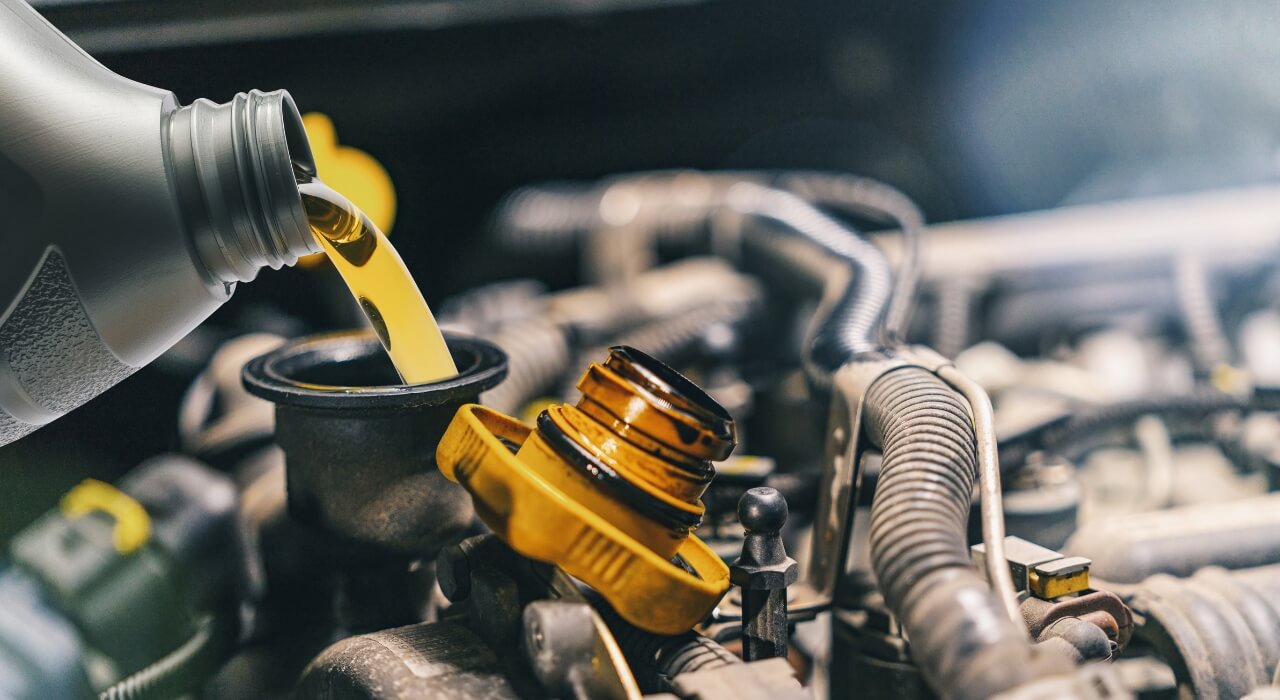






Thanks for the usefull information about motor oil. It helps me a lot to change my car’s oil.